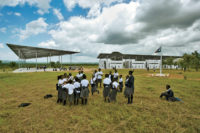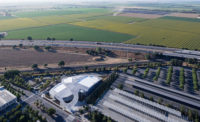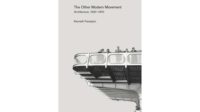The Christian monastery, among the most paradigmatic of building types, has for centuries retained the basic formula of a square plan around a cloistered garden. Nevertheless, since the Middle Ages, these complexes, including their church buildings, were often progressive examples of Western architecture. But long after religious communities ceased being the most influential patrons of the built environment, their leaders continued to support Modern architecture. And Modern architects have jumped at the chances, so few and far between, to interpret the building type in their own way. In the 1950s, both Le Corbusier and Marcel Breuer designed monastic buildings: the former, the Dominican monastery of Sainte-Marie-de-la-Tourette near Lyon, France; the latter, the lesser-known Benedictine complex for Saint John’s Abbey and University in Minnesota (and later, its sister institution, Annunciation Priory in North Dakota). In each case, the community leaders were looking for a bold design.
The same was not true for the Cistercian monks of Notre-Dame-du-Lac Abbey in Oka, outside Montreal. Their existing building, a late-19th-century stone structure designed to house over 150 monks at its peak, had become far too big for the community’s diminished population, reduced to just under 30 monks at the start of this century.
In the intervening years, the surrounding area also changed — from a place of peace and solitude to a highly trafficked corridor, in conflict with the order’s call for its monasteries to be located in areas remote from human intercourse.
Recently, when a community of Czech Cistercians relocated from France back to their homeland, they chose John Pawson as their architect, finding his Minimalism compatible with their ascetic lifestyle and traditional architecture [Record, September 2007, page 132]. The French- Canadian Cistercians at Oka instead sought a greater connection to nature, and saw in Pierre Thibault an architect whose sensitivity to the landscape, best exemplified in his residential projects [Record, July 2007, page 184], perfectly suited their way of life.
The Quebec architect was selected to build the new complex, Val Notre-Dame Abbey, at Saint-Jean-de-Matha, 80 miles northeast of Oka, following a 2004 competition. Though the monks were open to forms that deviated from that well-known paradigm — several such buildings were constructed after the order’s constitution reforms of 1969 — Thibault’s winning submission for a low, sprawling structure hidden among the trees maintained the ideal plan, with the church on the north side and the cloister immediately south of it.
Much of Thibault’s design adheres to traditional layouts to accommodate the tight programmatic requirements. For instance, the guest wing is on axis with the refectory, so that the common kitchen between the two serves both the monks and their guests. (Despite the order’s desire for seclusion, hospitality is one of its missions, and the monks often host visitors on short retreats.) The simple, unadorned elevations of the church and outer cloister, originally designed with stone but executed in white concrete panels, also follow tradition.
Thibault’s pared-down Modernism and preference for natural materials and basic construction details retain a touch of the vernacular. From the outside, his buildings, including the monastery, appear like found objects in nature, an achievement in itself. But it is from the inside that his architecture comes alive. At the monastery, the space that does so more than any other — through light, sound, and a spectacular 30-foot-high window onto nature — is the church. It is here that the monks spend most of their day, beginning at 4 a.m., with the first of seven daily offices.
The order’s rules dictate that the church face east, as Christ is seen in the rising sun. Thibault’s decision to terminate the apse in an entirely glazed wall, while not heretical, is certainly unorthodox. Throughout the day, the view changes dramatically; over the course of a year, even more so.
During predawn services, the wall appears solid black. Daylight hours treat churchgoers to a view where the slender trunks of silver birch trees peek out from the warmer months’ dense foliage or winter’s bare, snow-covered branches. A stray deer or coyote, and once even a bear, has wandered past during services. Birds have been known to add their song to the monks’ chanting.
Since chanting plays such a large role in the offices, Thibault paid special attention to the space’s acoustics. The nave’s permeable walls feature rows of wild-cherry planks, each slightly more inclined as they get higher so that the sum of the various angles forms a vaulted shape from bottom to top.
Thibault’s office designed the stalls by the altar where the monks face each other during services, and the pews where up to 120 visitors can be seated. The two are deliberately separated to avoid interaction between the monks, who enter and exit the church via side aisles, and the lay community.
The new monastery is a third the size of the former building at Oka, yet its cloister is larger. The full-height, triple-glazed units of the inner cloister’s lower level offer constant views of the garden and of passing monks on opposite sides. In the dark of night, small recessed lights placed a foot above the floor along all four faces of the cloister appear like floating candles in the glass reflections, an especially poignant vision when the monks are in procession to the first office of the day.
Thibault retained the existing plantings within the garden, whose sunken appearance happened quite by accident. The site’s high water table was discovered only after construction documents were completed. To address this unforeseen setback, Thibault raised much of the building by several feet.
While it might come as a surprise to some, the building incorporates state-of-the-art, 21st-century technologies, including a sophisticated, computerized building management system that monitors, among other things, the 14 geothermal wells located below a nearby parking lot. But then again, monasteries were among the first buildings to harness electrical power at the turn of the last century.
It was the monks’ desire to make the building’s environmental footprint as light as possible, so that the monastery not only exists in nature but respects it. Locally sourced wood was used for most of the structure and cedar cladding. Roofs over the lower levels, including by the individual cell’s private terraces, were planted. A drainage system collects rainwater and recycles gray water.
The biggest design challenge, however, had nothing to do with formal or practical concerns. The life of a monk is a contemplative one, where spirituality takes precedence over everything else. By connecting the interiors to the outside and, more important, by capturing light — both natural and artificial — Thibault created spaces with floors and walls that feel immaterial, the antithesis of Le Corbusier’s and Breuer’s brute concrete. The monastery’s inhabitants treasure this quality most. In the words of one monk, “La lumière est l’espace. It is the same thing.”
People
Architect
Principal and designer:
Design team:
Engineers:
Structural:
Consultants:
Landscape: |
Products
Wood structure:
Roofing:
Acoustical surfaces:
Elevator: |


















